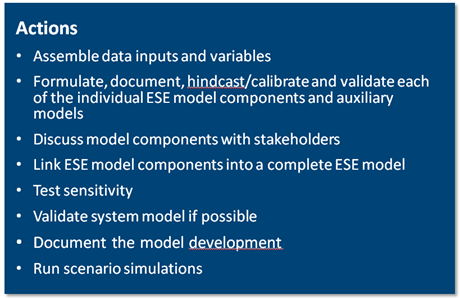The third step in the Systems Aproach Framework (SAF) is the System Formulation.
Actions
The system formulation step of the SAF consists of a list of actions, which you can access in the menu to find more about each action.

Building the integrated ESE model
During this step, we formulate and test the individual Ecological, Social and Economic (ESE) components of the scenario simulation model (sub-models), test model sensitivity, validate the model components and merge them into a integrated ESE model and run scenario simulations.
In this SAF Handbook we have further developed the tasks of the ESE modelling to ease the process by revising the tasks of the two modelling steps, Formulation and Appraisal as described in the first coastal SAF manual (available at www.coastal-saf.eu), and merging these two steps, into one step, System Formulation.
Here, we work to organize available data and information to empirically represent the system functioning (state and processes) in order to be able to simulate consequences of different management options.
We formulate the individual model components, the environmental, social/cultural and economic model blocks based on input data as well as output data from auxiliary models. This includes identification of all state variables (response variables) and all drivers (explanatory variables, co-variates) needed to simulate the processes relevant to each model component. Also, we identify and formulate the linkages between the ESE model components and merge them into the ESE model.
If independent data are available we test and validate the individual ESE sub-model components, as well as the integrated ESE model. Finally we run simulations of the potential scenarios chosen by the stakeholders and prepare the output for stakeholder deliberation in the next step, System Assessment.
Duration
The system formulation step may take 6-8 months, but in complex issues, or where more data needs to be procured, this may take longer.
Outcome
By the end of the system formulation step you have a complete ESE model (i.e. a bio-economical model) with which you can simulate the various scenarios chosen collaboratively by managers and stakeholders.
During this step, consultations with managers and stakeholders are vital to gain their acknowledgement and ownership of the model, and thereby trusting the modelling output.
All involved have gained a better insight to the problem and better awareness of how decisions may affect different parts of the system, different sectors and different stakeholders.
Learn more
Use the menu to learn more about the actions in the system formulation process.
Find e-learning material about system formulation in the Learn more box on this page.